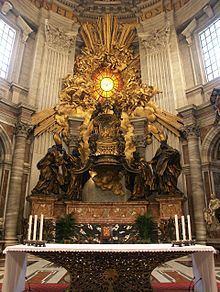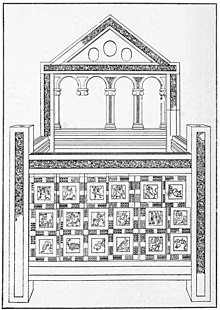Chair of Saint Peter
| Chair of Saint Peter | |
|---|---|
| Latin: Cathedra Petri | |
 | |
| Artist | Gian Lorenzo Bernini |
| Year | 1657–1666 |
| Catalogue | 61 |
| Type | Sculpture |
| Medium | Gilt bronze |
| Location | St. Peter's Basilica, Vatican City |
| 41°54′8″N 12°27′12″E / 41.90222°N 12.45333°E | |
| Preceded by | Habakkuk and the Angel (Bernini) |
| Followed by | Saints Jerome and Mary Magdalen (Bernini) |

The Chair of Saint Peter (
The wooden throne was a gift from Emperor of the Romans Charles the Bald to Pope John VIII in 875.[1] It has been studied many times over the years, most recently between 1968 and 1974, when it was last removed from the Bernini altar.[3] The study concluded that it was not a double, but a single chair, with a covering, and that the oldest parts are from the 6th century.[3] The Chair of Saint Peter is the second altar within the church with the first one being the one under the baldacchino. It stands to remind visitors of the Catholic Church's authority.[4]
Description
The relic itself is described as an oaken chair damaged by cuts and worms. The chair has metal rings attached to each side, allowing use as a sedia gestatoria. The back and front of the chair are trimmed with carved ivory. This description comes from 1867, when the relic was photographed and displayed for veneration.[5]
The
The cathedra is lofted on splayed scrolling bars that appear to be effortlessly supported by four over-lifesize bronze
arts, unifying sculpture and richly polychrome architecture and manipulating effects of light.Above, on the golden background of the frieze, is the Latin inscription: "
Feast of the Chair of Saint Peter
Early
According to historian Anton de Waal, although both feasts were originally associated with Saint Peter's stay in Rome, the ninth-century form of the Martyrologium Hieronymianum associated the January 18 feast with his stay in Rome, and the February 22 feast with his stay at Antioch.[5] The two feasts were included in the Tridentine calendar with the rank of Double, which Pope Clement VIII raised in 1604 to the newly invented rank of Greater Double.
In 1960
In the new classification of holy days introduced in 1969, the February 22 celebration has the rank of Feast.
See also
- List of works by Gian Lorenzo Bernini
- Index of Vatican City-related articles
Notes
- ^ In late 17th-century Venice, Andrea Brustolon constructed a few grandiose armchairs that employ similar sculptural figures doing duty as front legs and armrest supports.
References
- ^ a b c "Interior of the Basilica". Vatican State. Archived from the original on 16 May 2017. Retrieved 20 March 2013.
- ^ Akin, Jimmy (February 20, 2013). "9 things you need to know about the "Chair of St. Peter"". National Catholic Register. Retrieved 23 March 2016.
- ^ a b "The Chair of Peter". Catholic Exchange. Sophia Institute Press. February 22, 2016. Retrieved 23 March 2016.
- ^ "Gian Lorenzo Bernini, Cathedra Petri (Chair of St. Peter) – Smarthistory". smarthistory.org. Retrieved 2023-02-23.
- ^ a b c Waal, Anton de. "Chair of Peter." The Catholic Encyclopedia Vol. 3. New York: Robert Appleton Company, 1908
 This article incorporates text from this source, which is in the public domain.
This article incorporates text from this source, which is in the public domain.
- ^ John 21:17
- ^ See Gesamtkunstwerk
- ^ "The Tribune: Altar of the Chair of St. Peter". Retrieved 14 September 2014.
- ^ "Chair of Saint Peter", Franciscan Media
![]() This article incorporates text from a publication now in the public domain: Herbermann, Charles, ed. (1913). "Chair of Peter". Catholic Encyclopedia. New York: Robert Appleton Company.
This article incorporates text from a publication now in the public domain: Herbermann, Charles, ed. (1913). "Chair of Peter". Catholic Encyclopedia. New York: Robert Appleton Company.
External links
| External videos | |
|---|---|
 Media related to Cathedra Petri at Wikimedia Commons
Media related to Cathedra Petri at Wikimedia Commons- Altar of the Chair of St. Peter
- Catholic Encyclopedia: "Chair of St. Peter" — article contains photograph of the chair of Charles the Bald
- Encyclopædia Britannica Online: Gian Lorenzo Bernini
- "Masaryk University"
